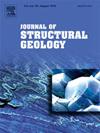A novel multi-scale approach to fault network analysis and visualization: test case Franconian Platform (SE Germany)
IF 2.9
2区 地球科学
Q2 GEOSCIENCES, MULTIDISCIPLINARY
引用次数: 0
Abstract
Faults are essential to reconstruct geologic histories and their presence (or absence) in the subsurface plays a significant role for many societal issues, such as geothermal energy, carbon, hydrogen and hydrocarbon storage or nuclear waste deposition. In the area of the Permo-Mesozoic Franconian Platform (Northern Bavaria, SE Germany) the existence and properties of faults in the subsurface are poorly known due to limited exposure and lack of geophysical data coverage.
To address this issue, we have constructed a new fault network based on stratigraphic offsets identified in a network of 18 cross sections. In this contribution, we present our workflow which allows the effective construction of an internally consistent cross-section network covering a study area of >30,000km2, while representing the geology in high detail. Data input is provided by > 3500 (mostly shallow) wells and >250 high-resolution geological maps, complemented by geophysical surveys and field data. We demonstrate how fault segments and their attributes (e.g., fault type, dip direction, offset, certainty of the interpretation, etc.) can be inferred from the profiles, resulting iteratively in consistent profile and fault networks.
While we highlight the non-uniqueness of the interpretation and its restriction to vertical offsets, we demonstrate advantages of the fault network, inferred through this pseudo-3D approach, compared to previously available datasets. We discuss the role of newly identified fault populations for Cretaceous inversion tectonics and Cenozoic rifting. Through the incorporation of basic measures of uncertainty and scale-dependency in the resulting fault model, quantification of the fault network can be achieved. This enables the comparison with independent datasets and different model realizations.
一种新的多尺度故障网络分析与可视化方法:测试用例Franconian平台(德国东南部)
断层对于重建地质历史至关重要,它们在地下的存在(或不存在)对许多社会问题起着重要作用,例如地热能、碳、氢和碳氢化合物的储存或核废料的沉积。在德国东南部巴伐利亚北部二叠-中生代弗朗哥尼亚地台地区,由于暴露有限和缺乏地球物理资料覆盖,对地下断裂的存在和性质知之甚少。为了解决这一问题,我们基于在18个剖面中识别的地层偏移构造了一个新的断层网。在这篇文章中,我们介绍了我们的工作流程,该工作流程可以有效地构建一个内部一致的横截面网络,覆盖30,000平方公里的研究区域,同时非常详细地表示地质情况。数据输入由>;3500口井(大部分是浅层井)和250张高分辨率地质图,并辅以地球物理调查和实地数据。我们演示了如何从剖面中推断出断层段及其属性(例如,断层类型,倾斜方向,偏移,解释的确定性等),从而迭代地得到一致的剖面和断层网络。虽然我们强调了解释的非唯一性及其对垂直偏移的限制,但与以前可用的数据集相比,我们展示了通过这种伪3d方法推断的断层网络的优势。讨论了新发现的断裂群在白垩纪逆构造和新生代裂陷中的作用。通过在得到的故障模型中引入不确定性和尺度依赖性的基本测度,可以实现故障网络的量化。这样可以与独立的数据集和不同的模型实现进行比较。
本文章由计算机程序翻译,如有差异,请以英文原文为准。
求助全文
约1分钟内获得全文
求助全文
来源期刊

Journal of Structural Geology
地学-地球科学综合
CiteScore
6.00
自引率
19.40%
发文量
192
审稿时长
15.7 weeks
期刊介绍:
The Journal of Structural Geology publishes process-oriented investigations about structural geology using appropriate combinations of analog and digital field data, seismic reflection data, satellite-derived data, geometric analysis, kinematic analysis, laboratory experiments, computer visualizations, and analogue or numerical modelling on all scales. Contributions are encouraged to draw perspectives from rheology, rock mechanics, geophysics,metamorphism, sedimentology, petroleum geology, economic geology, geodynamics, planetary geology, tectonics and neotectonics to provide a more powerful understanding of deformation processes and systems. Given the visual nature of the discipline, supplementary materials that portray the data and analysis in 3-D or quasi 3-D manners, including the use of videos, and/or graphical abstracts can significantly strengthen the impact of contributions.
 求助内容:
求助内容: 应助结果提醒方式:
应助结果提醒方式:


